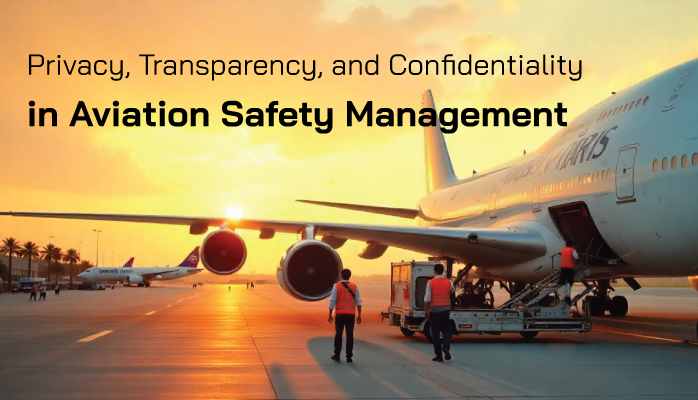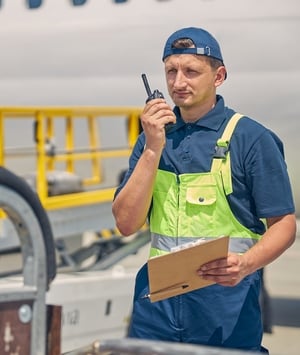What Are Responsibility, Confidentiality, and Privacy in Aviation Safety Management

In aviation safety management, responsibility, confidentiality, and privacy are the triad that affects how you handle reported safety information. Whether your organization is large or small, your leadership team needs to discuss these factors and decide how to handle them.
Your organization may decide that it doesn’t need to pay particular attention to this triad, or it may draft several pieces of formal documentation and policies about them. Either way, what is important is that as an aviation service provider:
- You know where your company stands on each item;
- Your stance on the triad matches company goals; and
- Your stance on the triad is consistent with your partners' and clients' needs.
Here is what responsibility, transparency, and confidentiality are in aviation safety management, and how your organization should handle each one.
What Is Confidentiality in Aviation Safety Management
Confidentiality in aviation Safety Management is how much personal information is included in available safety reports and other safety concerns. In other words, when reviewing safety reports/publications, how much information should employees know about:
- What people were involved;
- What departments were involved;
- What teams were involved; and
- What [you fill in the blank for identifying parties] were involved.
Confidentiality is about identifying information. Who do you want to be identified or not? Identifying information can be:
- Direct – you know what party was involved because they were named specifically
- Names of people
- Name of department
- Name of team/contractor
- Indirect – you know what party was involved based on implication
- Location information
- Equipment/aircraft/vehicle involved (consider a situation where only one party has access to a piece of equipment/aircraft – naming it would imply who was involved)
How to Handle Confidentiality in Aviation Safety Management

Leadership in your aviation SMS need to take a stance on confidentiality. It could be anything from:
- Leadership agreeing that they don’t care much about confidentiality; to
- Leadership drafting a formal confidentiality policy.
Either way, several factors affect what stance your organization takes regarding confidential information, including:
- The size of your company;
- What type of aviation service provider you are – your confidentiality stance should be on par with your clients
- Do you work with sensitive clients?
- Do you work with the government?
- Do you provide public service
- Existing Norms and safety culture in your organization;
- Company posture on safety transparency;
- Roles, responsibilities, and access to information;
- If you want information kept from auditors; and
- What personal information you are comfortable with including in safety reports
To structure your stance on confidentiality, you need to consider these factors.
Related Articles on Confidentiality in Aviation SMS
- Confidentiality in Aviation Safety Management
- How to Improve Confidence in Aviation SMS Implementations
- Should Reported Safety Issues Be Confidential in Aviation SMS
What Is Transparency in Aviation Safety Management
Transparency in aviation safety management is about how much safety information access employees have. Whereas confidentiality is concerned more with privacy and identifying information, transparency is how much types of information specific roles in your company can see.
Transparency affects things like whether or not:
- Employees can view other reports submitted in their division/department;
- Employees can view other reports submitted in their company;
- Employees can view what actions and decisions have been made on a reported concern;
- How they are notified of submitted issues;
- Who manages highly sensitive and confidential issues; and
- How involved employees are in change management.
Different Levels of Transparency

Aviation safety management systems with a range from:
- Low transparency – Employees have very limited access to reported information, for example:
- Front-line employees can only see issues they report
- Employees cannot see specific actions taken on issues unless management notifies them
- Strict user roles hierarchy in the SMS for view/management/access privileges
- Non-management employees have very little involvement in change management
- High transparency – employees have a lot of access to most reporting information, for example
- Front-line employees can see most issues reported in their division/company
- Employees can see actions taken on reported issues
- Some user role hierarchies, either documented or an “informal” hierarchy
- Employees are notified of changes and may be able to weigh in their opinion on the changes
Your organization will likely fall somewhere in between. Often times, organizations with low transparency tend to be either:
- Handling a lot of sensitive information;
- Operating with poor safety culture; or
- Large with numerous safety roles and responsibilities.
Organizations with high transparency tend to be either:
- Small with flexible safety roles and responsibilities;
- Operating with a mature safety culture; or
- Handling routine, non-sensitive information.
It’s a very good idea to have a commitment to transparency, be that a commitment to being open and available with information or being committed to keeping reported information secure and private.
Related Articles on Transparency in Aviation SMS
- A Key to Transparency in Aviation SMS
- Why Transparency Promotes Safety Culture in Aviation SMS
- How to Write SMS Commitments for Accountable Executives in Aviation
What Is Safety [Information] Responsibility in Aviation Safety
Safety information responsibility in aviation safety is about:
- How is your organization taking ownership of reported safety information; and
- Who is managing safety information?
Mismanagement of safety information (i.e., irresponsibility), usually winds up with:
- Safety information not being reported;
- Safety information being lost; or
- Inconsistent safety information, such as different spreadsheets with different information.
Your organizations need to ensure:
- All reported safety information is safe and reliable;
- Responsible managers are being accountable for reported information; and
- Employees are reporting safety concerns.
Responsibility is everyone’s job.
How to Handle Safety Information Responsibility Safety
Some good practices your organization can adapt to ensure safety information is owned, reliable, and reported are:
- Develop a mandatory/voluntary reporting policy;
- Perform internal audits/inspections on managed issues; and
- Invest in an SMS point solution or aviation safety management software to ensure that safety information is reliable.
In short, invest in the resources (tools, documentation) and ensure that safety information is handled well.
Last updated September 2025.






